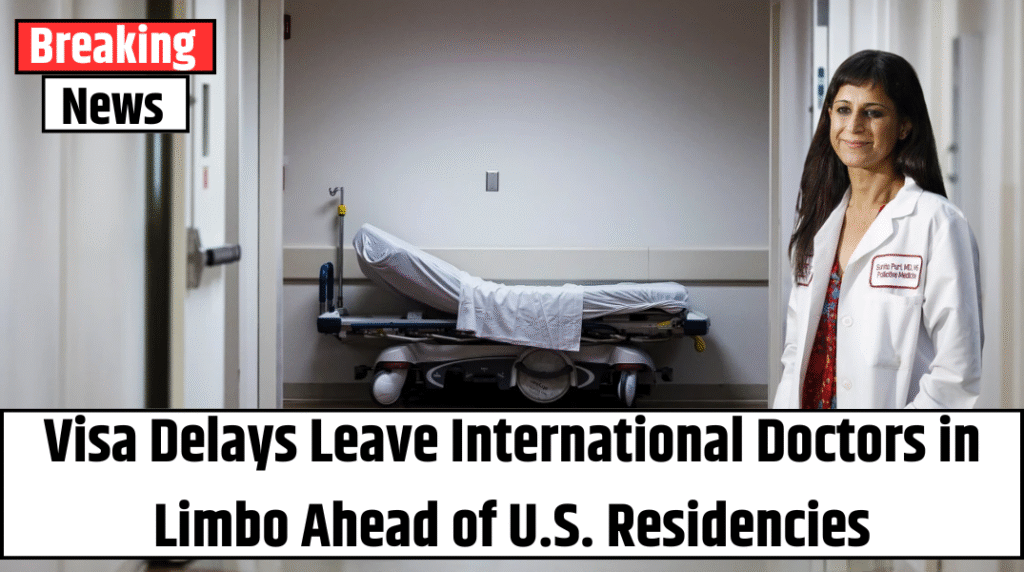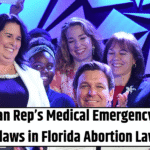With just days to go before thousands of new medical residents are scheduled to don white coats and start working in American hospitals, an alarming number of them are still stranded overseas — blocked not by medical exams or licensing issues, but by visa delays and travel restrictions.
These are not your average travelers. They’re newly matched doctors, often headed to hospitals in rural or underserved areas of the United States, places that rely heavily on international physicians to fill critical care gaps. But now, due to changes in the U.S. visa system and new social media scrutiny rules, many are stuck in bureaucratic limbo — unsure if they’ll arrive in time to begin training on July 1.
A Bottleneck Caused by Policy, Not Paperwork
The heart of the issue is the J-1 visa, the standard visa for international medical graduates (IMGs) pursuing U.S. residencies. In late May, the U.S. State Department suddenly paused J-1 processing while implementing new review policies, including requirements for applicants to make their social media activity publicly accessible for vetting.
Though the pause was recently lifted, the backlog and added hurdles have left hundreds of IMGs racing the clock. Some embassies still haven’t resumed appointment scheduling. Others are denying applications, especially for candidates from countries listed in the Trump administration’s expanded travel ban, which targets 19 nations.
“This isn’t just about the dreams of young doctors,” said Dr. Sebastian Arruarana, founder of Project IMG, an advocacy group for international medical students. “It’s about real patients who won’t get care.”
Also Read – FDA Approves Groundbreaking HIV Drug That Nearly Stops Transmission
Desperation and Refresh Buttons
Many IMGs are now obsessively refreshing embassy booking pages, hoping to land an elusive appointment slot in their home country — or even in neighboring nations. Some are being denied outright. Others report being told their cases require “additional processing,” a term that offers no timeline or guarantee of approval.
One doctor, matched to a pediatric residency in rural Texas, described the emotional toll. “I have spent years studying. I have gone into debt. I have missed weddings and funerals,” she said. “Now, I may lose everything because of a visa.”
Rural America Feels the Pinch
This year, more than 6,600 international doctors matched into U.S. residency programs, according to the National Resident Matching Program. A significant portion of them were assigned to hospitals in medically underserved areas, where they’re desperately needed.
In Kanawha County, West Virginia, three of nine incoming pediatric residents are currently blocked by the visa delay. “You can’t just replace three doctors in a program this size,” said Dr. Kseniia Tonkoshkurova, an IMG from Serbia who, along with her fiancé, was matched to the program. “It means longer wait times, more strain on staff, and worse care for children.”
A Broken Pipeline — and a Chilling Message
U.S. residency programs are not allowed to withdraw offers from international doctors, but they can apply for waivers to defer or release them from their commitments — something more programs may be forced to consider if IMGs don’t arrive on time.
Dr. Conrad Fischer, residency director at One Brooklyn Health in New York, said the effects of the current crisis could ripple into next year. “If this continues, international applicants may look elsewhere,” he said. “Canada, the U.K., Australia — these countries are competing for talent too.”
Also Read – New RSV Vaccine Approved for Infants as COVID and Measles Cases Rise in 2025
That’s bad news for the U.S., where rural counties, low-income neighborhoods, and immigrant communities often depend on foreign-born physicians — not only for language and cultural familiarity, but simply because many U.S. graduates choose to practice in urban centers or specialties over primary care.
Social Media Scrutiny and the ‘Rare Exception’ Loophole
Under the new rules, J-1 applicants must provide open access to all social media accounts, which will be reviewed for any anti-American sentiment, support of terrorism, or discriminatory content. Officials say this enhances national security, but critics warn that it creates fear and ambiguity.
“Applicants have no idea what qualifies as a red flag,” said Dr. Artur Polechshuk, a Serbian doctor whose visa interview is set for this week. “We post about our work. We’re not activists. But what if a joke is misinterpreted?”
For applicants from banned countries, the only route forward is to qualify for a “national interest exception.” That exception exists on paper, but the State Department has warned it will be rarely granted.
A Global Impact
While the U.S. health system benefits enormously from IMG labor, the training also empowers those doctors to improve care in their home countries. Dr. Gabriel Peña, a Venezuelan doctor matched to a residency in California, said he hopes to return home one day to help rebuild a crumbling medical infrastructure.
“The U.S. is where research happens, where protocols are created,” he said. “What I learn here will save lives in Venezuela.”
But Peña is also struggling to get his visa — and worries time is running out.
A Race Against the Calendar
Residency programs officially begin July 1. If doctors aren’t in place by then, hospitals will scramble to fill scheduling gaps. And with many specialties — like internal medicine, pediatrics, and psychiatry — already overstretched, there’s little margin for error.
Also Read – Maui Wildfire Survivors Still Battling Mental Health and Poverty, Study Finds
“Everyone is just waiting and hoping,” said Dr. Arruarana of Project IMG. “But hope isn’t a strategy. We need action.”
Final Thoughts
The U.S. health care system, especially in its most vulnerable corners, depends on international physicians to function. Delays and bans don’t just hurt aspiring doctors — they put patient lives at risk. If this crisis isn’t resolved in the next few days, the fallout could be felt long after July 1.



